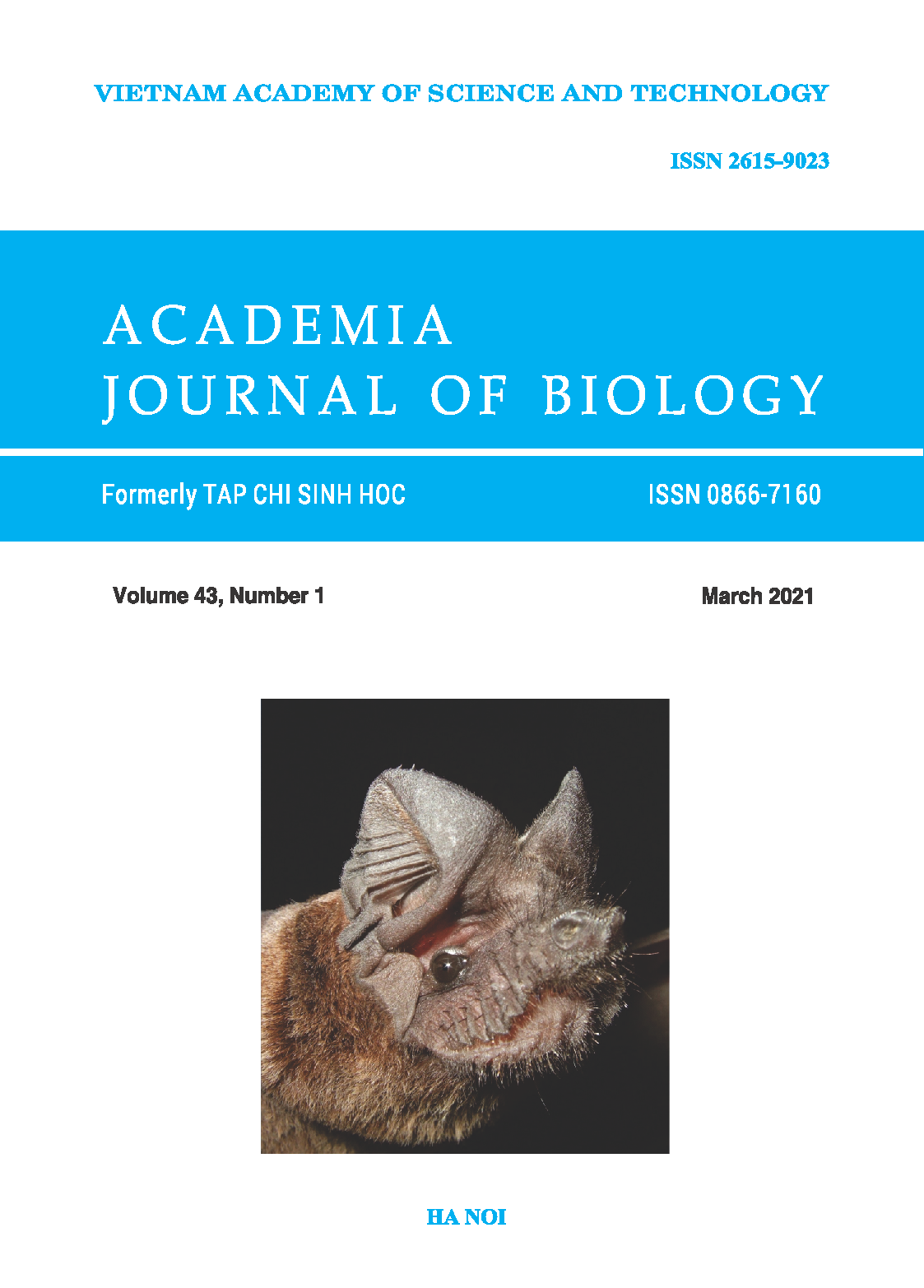Design and transfer of OsSWEET14-editing T-DNA construct to bac thom 7 rice cultivar
Author affiliations
DOI:
https://doi.org/10.15625/2615-9023/14923Keywords:
Bacterial leaf blight, Bac thom 7, CRISPR/Cas9, OsSWEET14, Xanthomonas oryzae.Abstract
Bac thom 7 rice (BT7 rice) is one of the major elite rice cultivars in Vietnam with superior productivity and quality but very susceptible to bacterial leaf blight caused by Xanthomonas oryzae pv. oryzae. The gene OsSWEET14, belonging to the OsSWEET family which encodes sugar transport proteins, is considered to be a susceptible gene involved in the virulence of Xoo. At least three cis-elements (EBE - Effector-binding element), including Tal5, PthXo3 and AvrXa7 on BT7 OsSWEET14 promoter, bind specifically to well-known transcription activator–like effectors (TALEs) of many Asian Xoo bacterium strains. In this study, a T-DNA construct which expressed the protein-RNA complex CRISPR/Cas for editing three EBEs position on the OsSWEET14 promoter was designed. The recombinant binary vector was tested by PCR, restriction enzyme and finally sequencing and then successfully transferred to Bac thom 7 rice through Agrobacterium tumefaciens. 28 of 30 hygromycin-resistant regenerated rice lines that grew and developed normally under nethouse conditions were selected by PCR with specific primers. Among these, twelve transgenic rice lines were identified carrying one copy of the T-DNA construct. The presence of CRISPR/Cas9-induced mutations of the targeted promoter in the transgenic plants were confirmed by T7EI assay. These results provide the basis to determine the role of OsSWEET14 in the susceptibility of Bac thom 7 rice to Xanthomonas oryzae pv. oryzae -caused disease, towards the further goal of generating an improved Bac thom 7 rice variety with broad-spectrum bacterial leaf blight resistance using CRISPR/Cas9 technology.
Downloads
Metrics
References
Blanvillain-Baufumé S., Reschke M., Solé M., Auguy F., Doucoure H., Szurek B., Meynard D., Portefaix M., Cunnac S., Guiderdoni E., Boch J., 2017. Targeted promoter editing for rice resistance to Xanthomoanas oryzae pv. oryzae reveals differential activities for SWEET14-inducing TAL effectors. Plant Biotechnology Journal, 15(3): 306−317.
Borkar S., Yumlembam R., 2016. Bacterial disease of crop plants. Florida: CRC Press.
Bortesi L., Fischer R., 2015. The CRISPR/Cas9 system for plant genome editing and beyond. Biotechnology Advances, 1(33): 41−52.
Doyle J., Doyle L., 1990. Isolation of plant DNA from fresh tissue. Focus, 12: 13−15.
Hiei Y., Ohta S., Komari T., Kumashiro T., 1994. Efficient transformation of rice (Oryza sativa L.) mediated by Agrobacterium and sequence analysis of the boundaries of the T-DNA. The Plant Journal, 6: 271−282.
Li T., Liu B., Spalding M.H., Weeks D.P., Yang B., 2012. High-efficiency TALEN-based gene editing produces disease-resistance rice. Nature Biotechnology, 30(5): 390−392.
Ma X., Zhang Q., Zhu Q., Liu W., Chen Y., Qiu R., Wang B., Yang Z., Li H., Lin Y., Xie Y., Shen R., Chen S., Wang Z., Chen Y., Guo J., Chen L., Zhao Z., Dong Z., Liu YG., 2015. A robust CRISPR/Cas9 system for convenient, high-effeciency multiplex genome editing in monocot and dicot plants. Molecular Plant, 8(8): 1274−1284.
Phuong N.D., Nghia P.T., Hoi P.X., 2015. Study on genetic transformation of Indica rice with drought-responsive OsNLI-IF gene, Journal of Biotechnology, 13(3): 1-10. (In Vietnamese with English summary).
Sahoo K.K., Tripathi A.K., Pareek A., Sopory S.K., Singla-Pareek S.L., 2011. An improved protocol for efficient transformation and regeneration of diverse indica rice cultivars. Plant Methods, 7(1): 49.
Sam V.H., Ha N.T., Quyen C.L., Phuong N.D., Hoi P.X., 2019. Funtional characterization of the OsSWEET14 gene involved in the infection of blight leaf bacteria in Bacthom7 variety rice. Science and Technology Jourrnal of Agriculture and Rural Development, 353(2): 13−19. (In Vietnamese with English summary).
Sambrook J., Russel D.W., 2001. A laboratory Manual, 3rd ed. New York: Cold Spring Harbour Laboratory Press, Cold Spring Harbour.
Slamet-Loedin I.H., Chadha-Mohanty P., Torrizo L., 2014. Agrobacterium-mediated transformation: rice transformation. Methods in Molecular Biology, 1099: 261−71.
Streubel J., Pesce C., Hutin M., Koebnik R., Boch J., Szurek B., 2013. Five phylogenetically close rice SWEET genes confer TAL effector-mediated susceptibility to Xanthomonas oryzae pv.oryzae. New Phytologist, 200(3): 808−819.
Wang K., 2006. Agrobacterium Protocols. Methods in Mol. Biol 343, 2nd ed. New Jersey: Humana Press, Totowa.
Wang K., 2007. Agrobacterium Protocols (Second edition ed.). Humana Press, New Jersey: Methods in Molecular Biology.
Yang L., Ding J., Zhang C., Jia J, Weng H., Liu W., Zhang D., 2005. Estimating the copy number of transgens in transformed rice by real-time quantitative PCR. Plant Cell Report, 23(10-11): 759−63.
Zhang Y., Zhang D., Li W., Chen J., Peng Y, Cao W., 2003. A novel real-time quatiative PCR method using attached univeral template probe. Nucleic Acids Resource, 31(20): e123.
Zischewski J., Fischer R., Bortesi L., 2017. Detection of on-target and off-target mutations generated by CRISPR/Cas9 and other sequence-specific nucleases. Biotechnology Advances, 35(1): 95−104.





